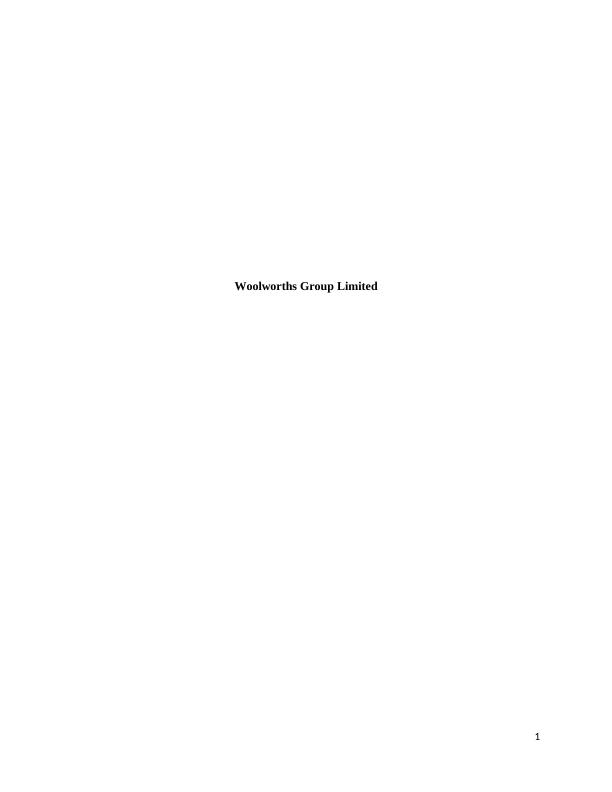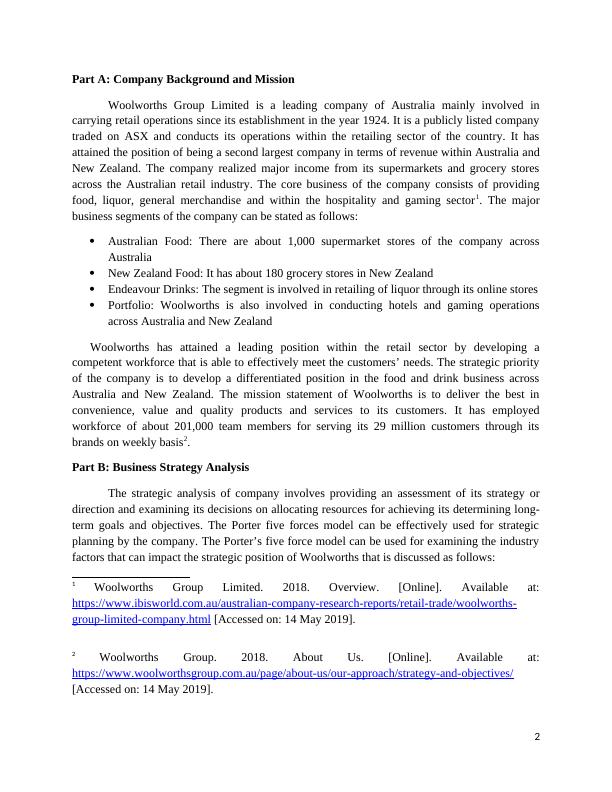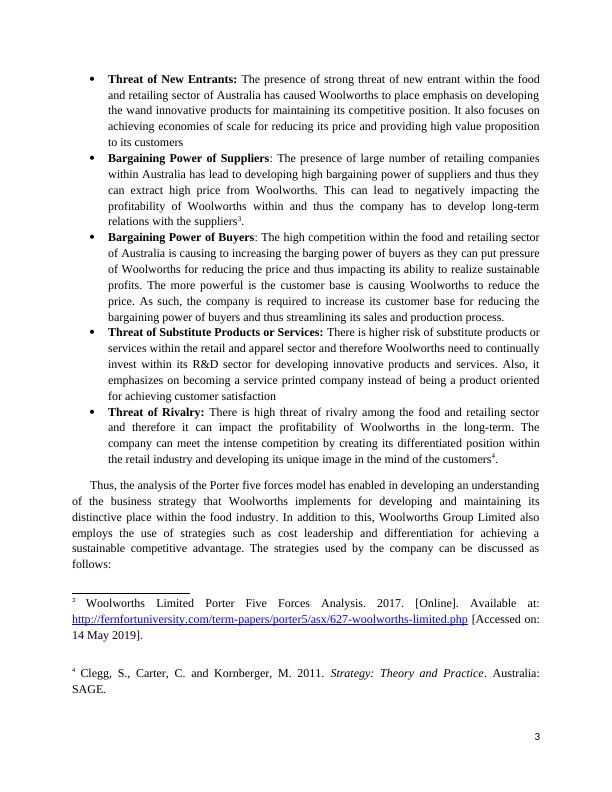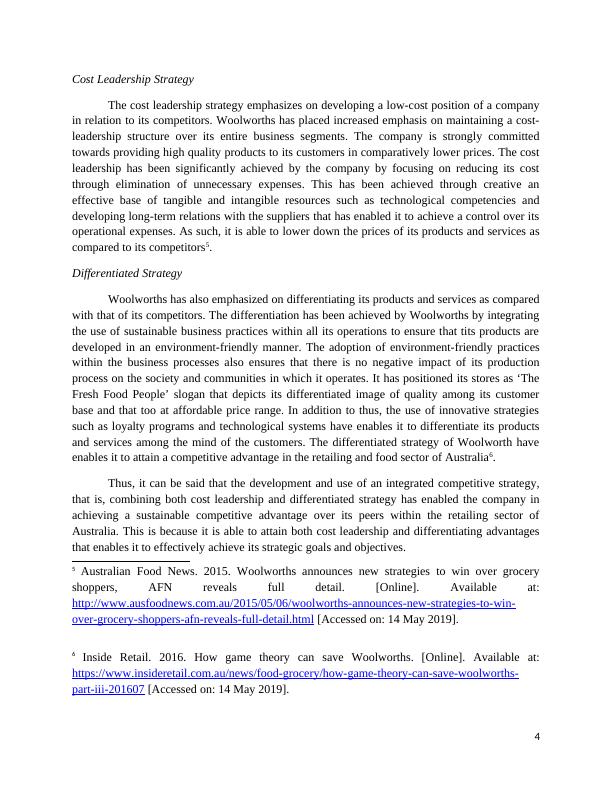Woolworths Group Limited: Company Background, Mission, and Business Strategy Analysis
Analyzing Woolworths Group Limited's company background, mission, business strategy, and accounting analysis.
12 Pages2936 Words78 Views
Added on 2023-03-20
About This Document
This document provides an overview of Woolworths Group Limited, including its company background, mission, and business strategy analysis. It also evaluates the accounting quality of the company through assessing its accounting policies and estimates.
Woolworths Group Limited: Company Background, Mission, and Business Strategy Analysis
Analyzing Woolworths Group Limited's company background, mission, business strategy, and accounting analysis.
Added on 2023-03-20
ShareRelated Documents
Woolworths Group Limited
1
1

Part A: Company Background and Mission
Woolworths Group Limited is a leading company of Australia mainly involved in
carrying retail operations since its establishment in the year 1924. It is a publicly listed company
traded on ASX and conducts its operations within the retailing sector of the country. It has
attained the position of being a second largest company in terms of revenue within Australia and
New Zealand. The company realized major income from its supermarkets and grocery stores
across the Australian retail industry. The core business of the company consists of providing
food, liquor, general merchandise and within the hospitality and gaming sector1. The major
business segments of the company can be stated as follows:
Australian Food: There are about 1,000 supermarket stores of the company across
Australia
New Zealand Food: It has about 180 grocery stores in New Zealand
Endeavour Drinks: The segment is involved in retailing of liquor through its online stores
Portfolio: Woolworths is also involved in conducting hotels and gaming operations
across Australia and New Zealand
Woolworths has attained a leading position within the retail sector by developing a
competent workforce that is able to effectively meet the customers’ needs. The strategic priority
of the company is to develop a differentiated position in the food and drink business across
Australia and New Zealand. The mission statement of Woolworths is to deliver the best in
convenience, value and quality products and services to its customers. It has employed
workforce of about 201,000 team members for serving its 29 million customers through its
brands on weekly basis2.
Part B: Business Strategy Analysis
The strategic analysis of company involves providing an assessment of its strategy or
direction and examining its decisions on allocating resources for achieving its determining long-
term goals and objectives. The Porter five forces model can be effectively used for strategic
planning by the company. The Porter’s five force model can be used for examining the industry
factors that can impact the strategic position of Woolworths that is discussed as follows:
1 Woolworths Group Limited. 2018. Overview. [Online]. Available at:
https://www.ibisworld.com.au/australian-company-research-reports/retail-trade/woolworths-
group-limited-company.html [Accessed on: 14 May 2019].
2 Woolworths Group. 2018. About Us. [Online]. Available at:
https://www.woolworthsgroup.com.au/page/about-us/our-approach/strategy-and-objectives/
[Accessed on: 14 May 2019].
2
Woolworths Group Limited is a leading company of Australia mainly involved in
carrying retail operations since its establishment in the year 1924. It is a publicly listed company
traded on ASX and conducts its operations within the retailing sector of the country. It has
attained the position of being a second largest company in terms of revenue within Australia and
New Zealand. The company realized major income from its supermarkets and grocery stores
across the Australian retail industry. The core business of the company consists of providing
food, liquor, general merchandise and within the hospitality and gaming sector1. The major
business segments of the company can be stated as follows:
Australian Food: There are about 1,000 supermarket stores of the company across
Australia
New Zealand Food: It has about 180 grocery stores in New Zealand
Endeavour Drinks: The segment is involved in retailing of liquor through its online stores
Portfolio: Woolworths is also involved in conducting hotels and gaming operations
across Australia and New Zealand
Woolworths has attained a leading position within the retail sector by developing a
competent workforce that is able to effectively meet the customers’ needs. The strategic priority
of the company is to develop a differentiated position in the food and drink business across
Australia and New Zealand. The mission statement of Woolworths is to deliver the best in
convenience, value and quality products and services to its customers. It has employed
workforce of about 201,000 team members for serving its 29 million customers through its
brands on weekly basis2.
Part B: Business Strategy Analysis
The strategic analysis of company involves providing an assessment of its strategy or
direction and examining its decisions on allocating resources for achieving its determining long-
term goals and objectives. The Porter five forces model can be effectively used for strategic
planning by the company. The Porter’s five force model can be used for examining the industry
factors that can impact the strategic position of Woolworths that is discussed as follows:
1 Woolworths Group Limited. 2018. Overview. [Online]. Available at:
https://www.ibisworld.com.au/australian-company-research-reports/retail-trade/woolworths-
group-limited-company.html [Accessed on: 14 May 2019].
2 Woolworths Group. 2018. About Us. [Online]. Available at:
https://www.woolworthsgroup.com.au/page/about-us/our-approach/strategy-and-objectives/
[Accessed on: 14 May 2019].
2

Threat of New Entrants: The presence of strong threat of new entrant within the food
and retailing sector of Australia has caused Woolworths to place emphasis on developing
the wand innovative products for maintaining its competitive position. It also focuses on
achieving economies of scale for reducing its price and providing high value proposition
to its customers
Bargaining Power of Suppliers: The presence of large number of retailing companies
within Australia has lead to developing high bargaining power of suppliers and thus they
can extract high price from Woolworths. This can lead to negatively impacting the
profitability of Woolworths within and thus the company has to develop long-term
relations with the suppliers3.
Bargaining Power of Buyers: The high competition within the food and retailing sector
of Australia is causing to increasing the barging power of buyers as they can put pressure
of Woolworths for reducing the price and thus impacting its ability to realize sustainable
profits. The more powerful is the customer base is causing Woolworths to reduce the
price. As such, the company is required to increase its customer base for reducing the
bargaining power of buyers and thus streamlining its sales and production process.
Threat of Substitute Products or Services: There is higher risk of substitute products or
services within the retail and apparel sector and therefore Woolworths need to continually
invest within its R&D sector for developing innovative products and services. Also, it
emphasizes on becoming a service printed company instead of being a product oriented
for achieving customer satisfaction
Threat of Rivalry: There is high threat of rivalry among the food and retailing sector
and therefore it can impact the profitability of Woolworths in the long-term. The
company can meet the intense competition by creating its differentiated position within
the retail industry and developing its unique image in the mind of the customers4.
Thus, the analysis of the Porter five forces model has enabled in developing an understanding
of the business strategy that Woolworths implements for developing and maintaining its
distinctive place within the food industry. In addition to this, Woolworths Group Limited also
employs the use of strategies such as cost leadership and differentiation for achieving a
sustainable competitive advantage. The strategies used by the company can be discussed as
follows:
3 Woolworths Limited Porter Five Forces Analysis. 2017. [Online]. Available at:
http://fernfortuniversity.com/term-papers/porter5/asx/627-woolworths-limited.php [Accessed on:
14 May 2019].
4 Clegg, S., Carter, C. and Kornberger, M. 2011. Strategy: Theory and Practice. Australia:
SAGE.
3
and retailing sector of Australia has caused Woolworths to place emphasis on developing
the wand innovative products for maintaining its competitive position. It also focuses on
achieving economies of scale for reducing its price and providing high value proposition
to its customers
Bargaining Power of Suppliers: The presence of large number of retailing companies
within Australia has lead to developing high bargaining power of suppliers and thus they
can extract high price from Woolworths. This can lead to negatively impacting the
profitability of Woolworths within and thus the company has to develop long-term
relations with the suppliers3.
Bargaining Power of Buyers: The high competition within the food and retailing sector
of Australia is causing to increasing the barging power of buyers as they can put pressure
of Woolworths for reducing the price and thus impacting its ability to realize sustainable
profits. The more powerful is the customer base is causing Woolworths to reduce the
price. As such, the company is required to increase its customer base for reducing the
bargaining power of buyers and thus streamlining its sales and production process.
Threat of Substitute Products or Services: There is higher risk of substitute products or
services within the retail and apparel sector and therefore Woolworths need to continually
invest within its R&D sector for developing innovative products and services. Also, it
emphasizes on becoming a service printed company instead of being a product oriented
for achieving customer satisfaction
Threat of Rivalry: There is high threat of rivalry among the food and retailing sector
and therefore it can impact the profitability of Woolworths in the long-term. The
company can meet the intense competition by creating its differentiated position within
the retail industry and developing its unique image in the mind of the customers4.
Thus, the analysis of the Porter five forces model has enabled in developing an understanding
of the business strategy that Woolworths implements for developing and maintaining its
distinctive place within the food industry. In addition to this, Woolworths Group Limited also
employs the use of strategies such as cost leadership and differentiation for achieving a
sustainable competitive advantage. The strategies used by the company can be discussed as
follows:
3 Woolworths Limited Porter Five Forces Analysis. 2017. [Online]. Available at:
http://fernfortuniversity.com/term-papers/porter5/asx/627-woolworths-limited.php [Accessed on:
14 May 2019].
4 Clegg, S., Carter, C. and Kornberger, M. 2011. Strategy: Theory and Practice. Australia:
SAGE.
3

Cost Leadership Strategy
The cost leadership strategy emphasizes on developing a low-cost position of a company
in relation to its competitors. Woolworths has placed increased emphasis on maintaining a cost-
leadership structure over its entire business segments. The company is strongly committed
towards providing high quality products to its customers in comparatively lower prices. The cost
leadership has been significantly achieved by the company by focusing on reducing its cost
through elimination of unnecessary expenses. This has been achieved through creative an
effective base of tangible and intangible resources such as technological competencies and
developing long-term relations with the suppliers that has enabled it to achieve a control over its
operational expenses. As such, it is able to lower down the prices of its products and services as
compared to its competitors5.
Differentiated Strategy
Woolworths has also emphasized on differentiating its products and services as compared
with that of its competitors. The differentiation has been achieved by Woolworths by integrating
the use of sustainable business practices within all its operations to ensure that tits products are
developed in an environment-friendly manner. The adoption of environment-friendly practices
within the business processes also ensures that there is no negative impact of its production
process on the society and communities in which it operates. It has positioned its stores as ‘The
Fresh Food People’ slogan that depicts its differentiated image of quality among its customer
base and that too at affordable price range. In addition to thus, the use of innovative strategies
such as loyalty programs and technological systems have enables it to differentiate its products
and services among the mind of the customers. The differentiated strategy of Woolworth have
enables it to attain a competitive advantage in the retailing and food sector of Australia6.
Thus, it can be said that the development and use of an integrated competitive strategy,
that is, combining both cost leadership and differentiated strategy has enabled the company in
achieving a sustainable competitive advantage over its peers within the retailing sector of
Australia. This is because it is able to attain both cost leadership and differentiating advantages
that enables it to effectively achieve its strategic goals and objectives.
5 Australian Food News. 2015. Woolworths announces new strategies to win over grocery
shoppers, AFN reveals full detail. [Online]. Available at:
http://www.ausfoodnews.com.au/2015/05/06/woolworths-announces-new-strategies-to-win-
over-grocery-shoppers-afn-reveals-full-detail.html [Accessed on: 14 May 2019].
6 Inside Retail. 2016. How game theory can save Woolworths. [Online]. Available at:
https://www.insideretail.com.au/news/food-grocery/how-game-theory-can-save-woolworths-
part-iii-201607 [Accessed on: 14 May 2019].
4
The cost leadership strategy emphasizes on developing a low-cost position of a company
in relation to its competitors. Woolworths has placed increased emphasis on maintaining a cost-
leadership structure over its entire business segments. The company is strongly committed
towards providing high quality products to its customers in comparatively lower prices. The cost
leadership has been significantly achieved by the company by focusing on reducing its cost
through elimination of unnecessary expenses. This has been achieved through creative an
effective base of tangible and intangible resources such as technological competencies and
developing long-term relations with the suppliers that has enabled it to achieve a control over its
operational expenses. As such, it is able to lower down the prices of its products and services as
compared to its competitors5.
Differentiated Strategy
Woolworths has also emphasized on differentiating its products and services as compared
with that of its competitors. The differentiation has been achieved by Woolworths by integrating
the use of sustainable business practices within all its operations to ensure that tits products are
developed in an environment-friendly manner. The adoption of environment-friendly practices
within the business processes also ensures that there is no negative impact of its production
process on the society and communities in which it operates. It has positioned its stores as ‘The
Fresh Food People’ slogan that depicts its differentiated image of quality among its customer
base and that too at affordable price range. In addition to thus, the use of innovative strategies
such as loyalty programs and technological systems have enables it to differentiate its products
and services among the mind of the customers. The differentiated strategy of Woolworth have
enables it to attain a competitive advantage in the retailing and food sector of Australia6.
Thus, it can be said that the development and use of an integrated competitive strategy,
that is, combining both cost leadership and differentiated strategy has enabled the company in
achieving a sustainable competitive advantage over its peers within the retailing sector of
Australia. This is because it is able to attain both cost leadership and differentiating advantages
that enables it to effectively achieve its strategic goals and objectives.
5 Australian Food News. 2015. Woolworths announces new strategies to win over grocery
shoppers, AFN reveals full detail. [Online]. Available at:
http://www.ausfoodnews.com.au/2015/05/06/woolworths-announces-new-strategies-to-win-
over-grocery-shoppers-afn-reveals-full-detail.html [Accessed on: 14 May 2019].
6 Inside Retail. 2016. How game theory can save Woolworths. [Online]. Available at:
https://www.insideretail.com.au/news/food-grocery/how-game-theory-can-save-woolworths-
part-iii-201607 [Accessed on: 14 May 2019].
4

End of preview
Want to access all the pages? Upload your documents or become a member.
Related Documents
Strategic Management - Woolworthslg...
|11
|3089
|103
Cloud-Based Accounting Software for Woolworths Group Limitedlg...
|12
|2877
|46
Strategic Information System for Woolworths: Market Analysis and Competitor Evaluationlg...
|16
|3245
|251
Woolworths: PESTEL and Porter's Five Forces Analysislg...
|15
|799
|257
Business Analysis and Valuation of Woolworths Group Limitedlg...
|17
|3375
|54
Organisation’s Woolworths Activitieslg...
|10
|3119
|32
